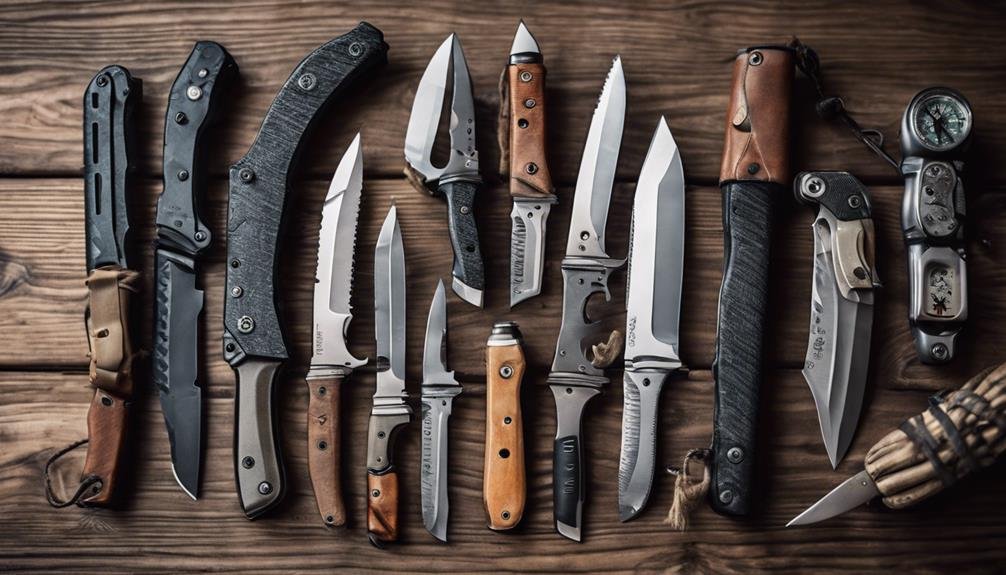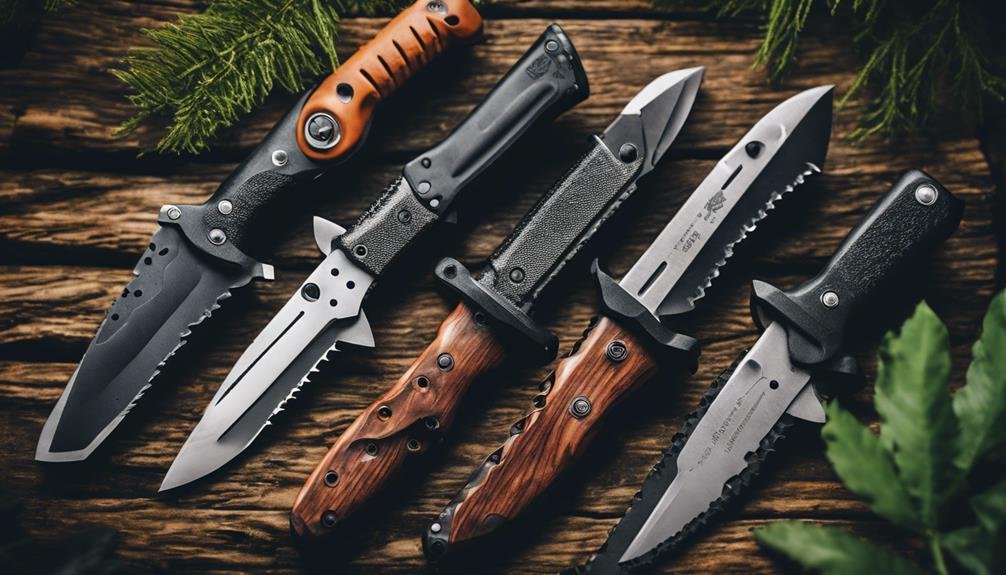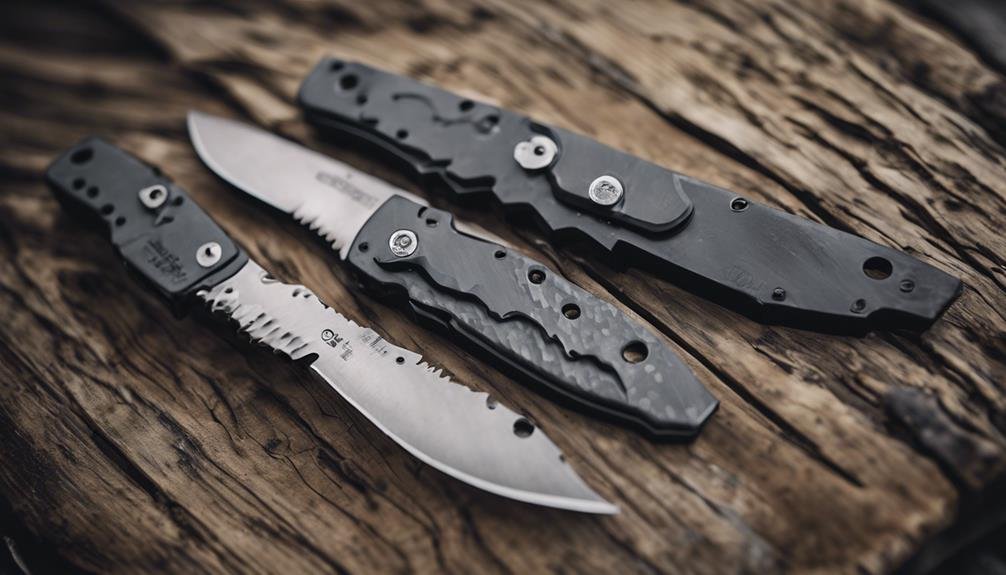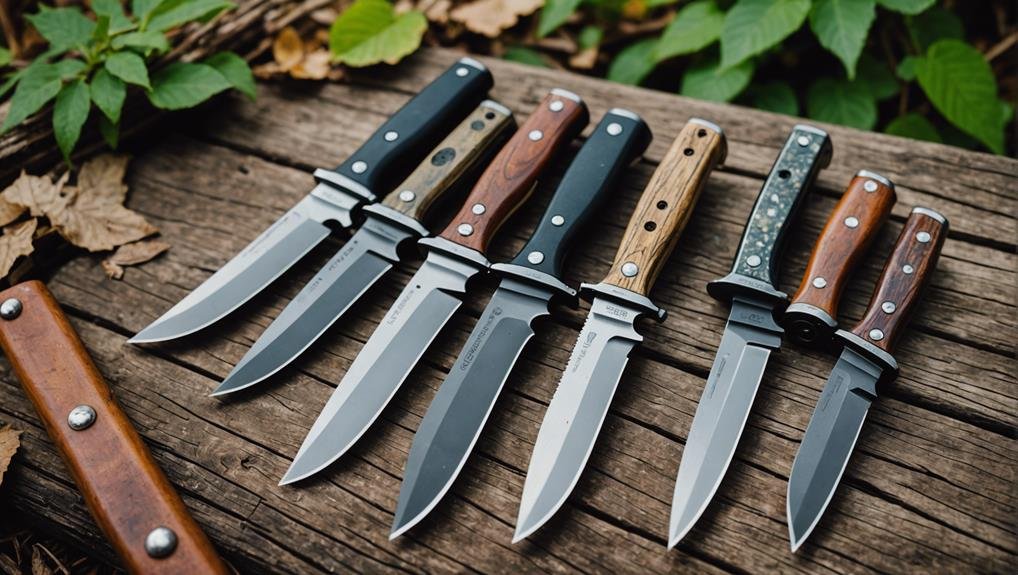When you’re miles from civilization, and your survival depends on a single piece of gear, choosing your knife isn’t just important; it’s vital. It would be best to have a tool that’s as reliable as it is versatile—whether you’re kindling a fire, building a shelter, or preparing a meal. In the upcoming reviews, we’ll compare the top models like the Ka-Bar Becker BK2 and the Gerber LMF II, highlighting how each performs under pressure. But before settling on your trusty companion, consider what sets a high-quality survival knife apart. What do you think is the most critical feature of a survival knife?
Key Takeaways
- Review popular survival knives like Ka-Bar Becker BK2 and Gerber LMF II for their specific features and performance.
- Assess blade materials such as stainless and carbon steel for durability and maintenance needs.
- Evaluate ergonomic features like grip texture and balance for user comfort and control.
- Consider additional accessories like upgraded sheaths and lanyards for enhanced functionality.
- Check maintenance tips to ensure the longevity and optimal performance of the knife.
Understanding Survival Knife Basics

A survival knife is an essential tool you shouldn’t overlook when preparing for any outdoor adventure. Whether planning a camping trip, a hiking expedition, or a survival scenario, having a reliable knife can make a significant difference. Understanding how to use one and where it’s legal to carry one is vital. Knife legality varies widely from place to place, so you’ll need to check local laws before packing your gear. Some regions might restrict the length of the blade or ban certain types of survival knives altogether.
Regarding usage scenarios, a survival knife proves its worth in countless ways. Imagine you’re deep in the woods and need to create shelter; a sturdy knife is indispensable for cutting branches and carving wood. Or consider a situation where you must prepare food in the wild; your survival knife will be your go-to tool for slicing, dicing, and even hunting if necessary. Additionally, a survival knife can be used in emergencies for first aid, such as cutting bandages or fashioning splints. Knowing how to effectively leverage your knife’s capabilities can drastically elevate your chances of thriving in the wild.
Key Features to Consider
When selecting a survival knife, consider blade material, handle ergonomics, and overall durability as key factors. Blade material determines the knife’s ability to withstand rough use and maintain sharpness. Handle ergonomics ensure you’re comfortable using the knife for prolonged periods, particularly in survival situations. Durability is vital as it dictates how well the knife holds up under harsh conditions.
Size relevance is another critical aspect. A larger knife might seem more useful, but balancing size with ease of carry is important. Conversely, a very small knife, while easy to carry, may not perform well in all survival tasks.
Design versatility refers to the knife’s ability to handle various tasks. The design should offer flexibility from preparing food to cutting through tough material. Consider the features that enhance versatility, such as a serrated edge, a full tang, and a comfortable, non-slip grip.
Here’s how various features stack up:
| Feature | Importance | Why It Matters |
|---|---|---|
| Blade Material | High | Affects durability |
| Handle Ergonomics | Medium | Impacts user comfort |
| Size Relevance | Medium | Balances utility & portability |
| Design Versatility | High | Enhances functionality |
Choose wisely, as the right knife can be a lifeline in the wilderness.
Top 5 Survival Knives Analysed

Let’s explore the top 5 survival knives currently on the market, examining their features and performance to assist you in making an informed decision.
First, the Ka-Bar Becker BK2 boasts a robust design ideal for heavy-duty tasks. When compared to other brands, Ka-Bar’s reputation for durability stands out, especially when compared against newer brands like TAC Force. However, the BK2’s sheath quality has mixed reviews, with some users noting its bulkiness.
Next, the Gerber LMF II Survival Knife offers a balanced approach with a versatile design. The sheath is exceptionally well-made, providing secure storage and accessibility. This contrasts sharply with budget options, where sheath quality is often compromised to cut costs.
The ESEE 6P is a favorite among survival experts due to its superior craftsmanship. Brand comparisons highlight ESEE’s commitment to quality, reflected in the durable and thoughtfully designed knife and sheath.
The Morakniv Bushcraft Survival Knife shines with its razor-sharp edge and anti-corrosive coating. While the brand is less known than others like Gerber, its sheath quality is commendable, offering a dependable and weather-resistant cover.
Lastly, with its lightweight design, the SOG Seal Pup Elite is perfect for those who prioritize ease of carry. The sheath is robust, designed for quick access and safe handling, and stands up well against more expensive brands.
Handling and Ergonomics
Moving on to handling and ergonomics, you’ll find that each knife’s grip design greatly influences its practical usability in diverse survival scenarios. The grip texture and the balance point are pivotal factors determining how well you can manage the knife when cutting, carving, or performing precision tasks. A well-textured grip guarantees that the knife won’t slip from your hands in wet conditions, which is vital if you’re near bodies of water or in humid environments.
You should also pay close attention to the knife’s balance point, which ideally should be near the center of the knife. This balance helps distribute the weight evenly, making it easier to control the knife with less fatigue. If the balance point is off, you’ll find it awkward to handle the knife effectively, leading to increased strain on your wrist and forearm and potentially decreasing the precision with which you can use the knife.
Ergonomically designed handles that contour to your hand can greatly reduce discomfort during prolonged use. These features enhance your grip stability and overall control, ensuring you can use your knife efficiently and safely, regardless of the survival scenario.
Blade Materials and Durability

Understanding the blade material’s types and durability is crucial for selecting a survival knife that will withstand harsh conditions. The right material guarantees longevity and enhances the knife’s performance in various environments. Here’s what you need to focus on:
- Stainless Steel: Known for its corrosion resistance, stainless steel is a popular choice if you’re frequently in wet conditions. However, the level of carbon content can vary, affecting its hardness and edge retention. Stainless steel blades undergo specific heat treatment processes to improve these qualities without compromising their innate resistance to rust.
- Carbon Steel: This material is prized for its extreme durability and ease of sharpening. High carbon steel blades are typically tougher than their stainless counterparts and hold an edge longer. However, they lack corrosion resistance and require more maintenance to prevent rust. Proper heat treatment can enhance their resilience and wear resistance.
- Tool Steel: Tool steels are alloyed with elements like tungsten, molybdenum, and vanadium, which boost their hardness and durability. They can withstand heavy use and repeated impacts, making them ideal for rugged survival scenarios. However, similar to carbon steel, they need regular care to combat corrosion.
Choosing the right blade material depends on understanding these properties and how they’ll handle your real-world challenges.
Price Versus Performance
While selecting a blade material that suits your needs is important, you should also consider how the cost of a survival knife reflects its performance and overall value. Don’t be fooled into thinking that the priciest option is always the best. Market trends show that mid-range priced knives often provide the best balance between quality and cost.
Consumer testimonials are a goldmine of information, revealing that some of the most expensive knives offer features you might never use, while more affordable models perform admirably under tough conditions. You must assess what you’re paying for. Is it the brand name, or is it genuine quality and durability?
You’ve got to ask yourself: Are those extra dollars adding to the blade’s performance or just its aesthetic? Market trends suggest manufacturers respond by creating cost-effective models that don’t compromise on quality as the demand for durable, multi-functional survival knives increases.
Maintenance and Care Tips

Regular maintenance is essential to keep your survival knife in top condition. Proper care prolongs your knife’s lifespan and guarantees it’s ready when needed. Here’s how you can maintain your knife effectively:
- Cleaning Techniques:
- After each use, clean your knife thoroughly. Use mild soap and water to remove any dirt or debris. Avoid harsh chemicals that can damage the blade’s material. Dry it completely to safeguard against rust.
- Storage Solutions:
- Store your knife in a dry, cool place. Humidity and heat can cause corrosion and damage the handle materials. A sheath or storage box can safeguard the blade from moisture and physical damage, keeping it sharp and pristine.
- Regular Inspections:
- Regularly check your knife for any signs of wear or damage. Look for chips on the blade, looseness in the handle, or rust spots. Addressing these issues early can prevent further damage and preserve the knife’s functionality.
Recommended Accessories
Consider investing in these recommended accessories to enhance your survival knife’s functionality and longevity. Key among these are sheath upgrades and lanyard options, which not only boost your knife’s utility but also guarantee its safety and accessibility.
A quality sheath protects your blade and ensures it’s ready when needed. Look for sheaths made from durable materials like Kydex or leather. Some sheaths offer additional features like built-in sharpeners or fire starters. Upgrading your sheath can prevent damage to your knife and allow you to carry it more securely.
Lanyard options are another smart accessory. Adding a lanyard to your survival knife can improve its handling and make it easier to retrieve quickly. Choose a lanyard made from sturdy materials like paracord, which can also be used in emergencies to build shelters or set traps. You can customize the color and length to suit your needs and preferences.
Conclusion
In wrapping up, choosing the right survival knife is essential for your outdoor adventures. Remember to prioritize blade quality, handle comfort, and overall durability.
Regular maintenance is key if you opt for the Ka-Bar Becker BK2 or the SOG Seal Pup Elite. Keep it clean, dry, and sharp, and invest in handy accessories like a sharpener and sheath.
With the right care, your survival knife will be a dependable companion.
FAQs
What makes a survival knife different from a regular knife?
A survival knife is designed to handle various outdoor and survival tasks, such as cutting, chopping, and prying. Unlike regular knives, survival knives typically have a fixed blade for increased strength and a full tang design for durability. They often feature additional elements like serrated edges and built-in fire starters.
How should I choose the right survival knife for my needs?
When choosing a survival knife, consider the blade material (high-carbon steel for durability), blade length (typically 4-7 inches for versatility), and handle design (comfortable and non-slip grip). Additionally, assess the knife’s weight and balance to ensure it suits your intended use, whether for camping, bushcraft, or emergencies.
What are some common uses for a survival knife in the wild?
In the wild, a survival knife can be used to build shelters, prepare food, cut rope, and start fires. It is also useful for self-defense, first aid (like cutting bandages), and crafting tools. A versatile survival knife is an essential tool for any outdoor or emergency kit, providing multiple functions in a compact form.

